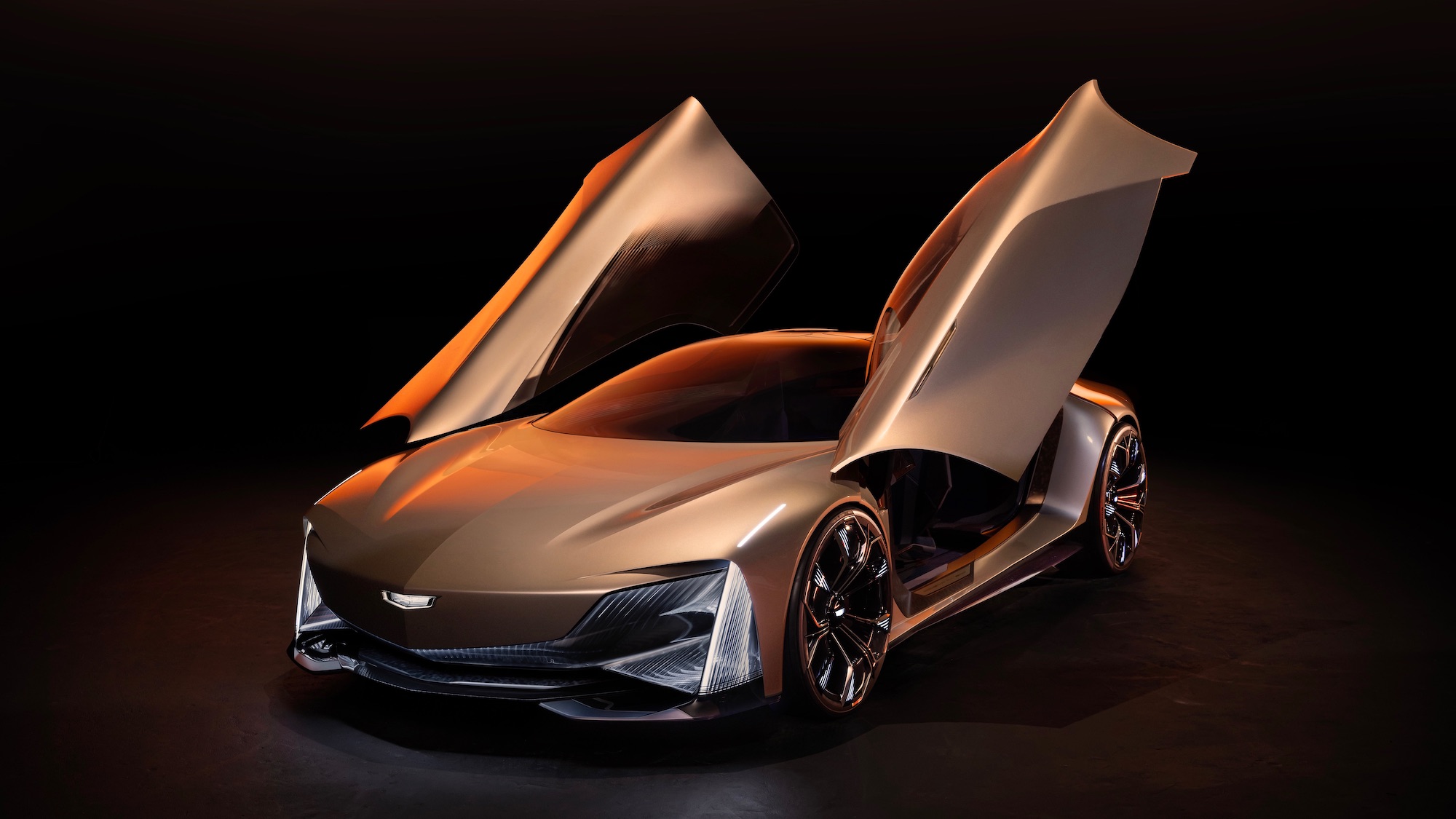A few weeks ago, Cadillac sent the internet into paroxysms of awe and envy with the unveiling of its Sollei concept car. Swathed in Manila Cream, a pale yellow paint hue Cadillac used in the late 1950s, the Sollei is decked out with a 55-inch screen across the dash and intricate hand-cut woodworking behind the seats. The Sollei is a mix of old and new, featuring new technology and materials fashioned from the renewable root structure of mushrooms while keeping its throwback feel.
In sharp contrast, Cadillac’s newly revealed Opulent Velocity concept is futuristic and angular. The American brand pulled the cover from Opulent Velocity, and it’s an ultramodern look at the future of the automaker. This concept foretells where Cadillac hopes to go with its electric vehicle lineup, and it makes a strong statement. If the Sollei evokes the classic elegance of Greta Garbo, Opulent Velocity is more like SZA, one of the hottest and most current music artists on the planet. One holds back a little in the best ways, placing all of its plushness front and center. The other screams “get out of my way” with just enough bravado to convince potential buyers that it has a chance to make it to production.
Along with Cadillac’s highly anticipated hand-built Celestiq, the newest concept is seething with ultramodern chic and seems to be gunning for its European luxury competition. All of that, plus the upcoming electric version of Cadillac’s popular Escalade SUV, was on display last week during Monterey Car Week.
Cadillac unleashes its digital imagination
Make no mistake: Software defines the next generation of the GM brand’s vehicles. Tony Roma, most recently the chief engineer for the Celestiq and now the leader of the Corvette development team, told me during Monterey Car Week that Opulent Velocity was “80 percent done” once the software part was complete. Digital fabrication plays a big role, giving designers and engineers room for their imaginations to roam.
To that end, the all-electric Opulent Velocity coupe looks like a proper poster-worthy hypercar, with butterfly doors that hinge at the A-pillar and swing upward. Inside the cabin, 3D printing and hard torched painting techniques highlight levitating seats and an instrument panel that appears to float above the floor mats. It’s more spaceship than supercar.

“We’re bringing the brand back to a place of real American luxury relevance,” says GM President Mark Reuss. “We had a lot of doubters when we started that journey and we’ve made some pretty meaningful steps forward. GM showed its commitment and investment to the whole portfolio.”
Reuss highlights another big step: reintroducing Cadillac into places like Europe and Australia. It’s time to step back and look at what’s coming over the horizon from a design, technology, performance, and statement for what Cadillac is going to become, he says.
Opulent Velocity, true to its compound name, strives to deliver two very different experiences. One side of the coin is opulence, boasting full luxury and autonomy. Even the wheel and pedals retract in Opulent mode to pump up the total space. Take a sharp right toward Velocity, which amplifies the car’s performance attributes and turns the cabin into a focused racing control center.
Weathering the storm of EV uncertainty
CNBC reported last week that Cadillac’s sales were down 1.7 percent compared with the first six months of 2023. Each of Cadillac’s vehicles took a sales hit except for one notable exception: the all-electric Cadillac Lyriq. The automaker isn’t backing down from what it calls its “new, electrified face” through the Lyriq and Celestiq (pronounced sell-ESS-tick). Meanwhile, some headlines proclaim EVs are slowing way down, according to analysts from firms like Goldman Sachs and Cox Automotive.
Still, Reuss believes in staying the course. EVs are inevitable, and Cadillac wants to be in the forefront.
“The power of delivery with electrification and its instant torque is so satisfying,” he says.
While speaking with GM Vice President of Global Design Michael Simcoe during Car Week, he pointed out a few Easter eggs in both the Sollei and the Celestiq. Both bear design elements that point to the past, from a 1930s-era vehicle to a 1957 Cadillac model and the newest concepts as the crowning glory for this automaker.
Simcoe, Reuss, and the rest of the GM team understand that wild designs turn heads—just look at the CyberTruck—but giving the world a set of future cars that offers more than just shock and flash will serve it well.

